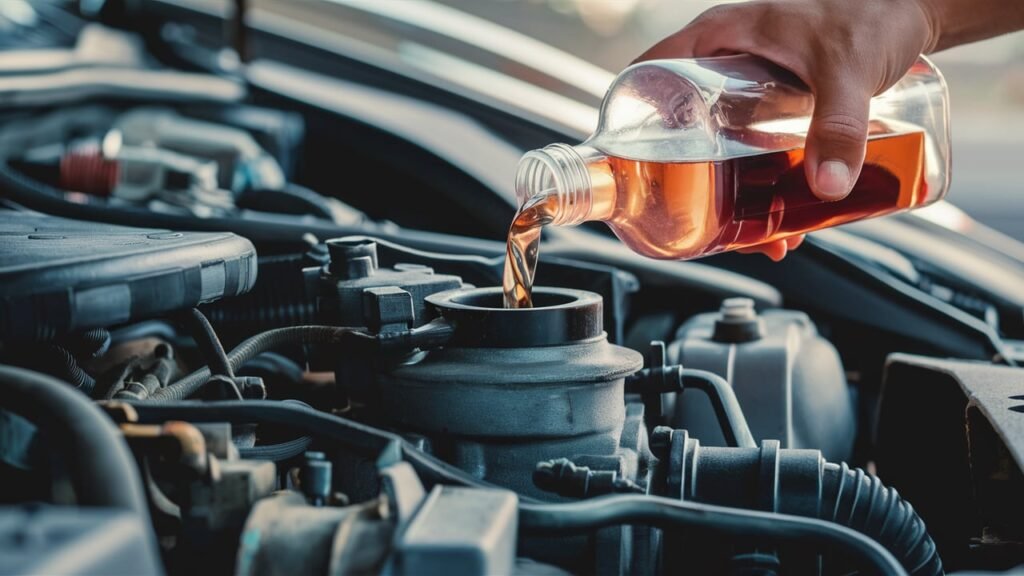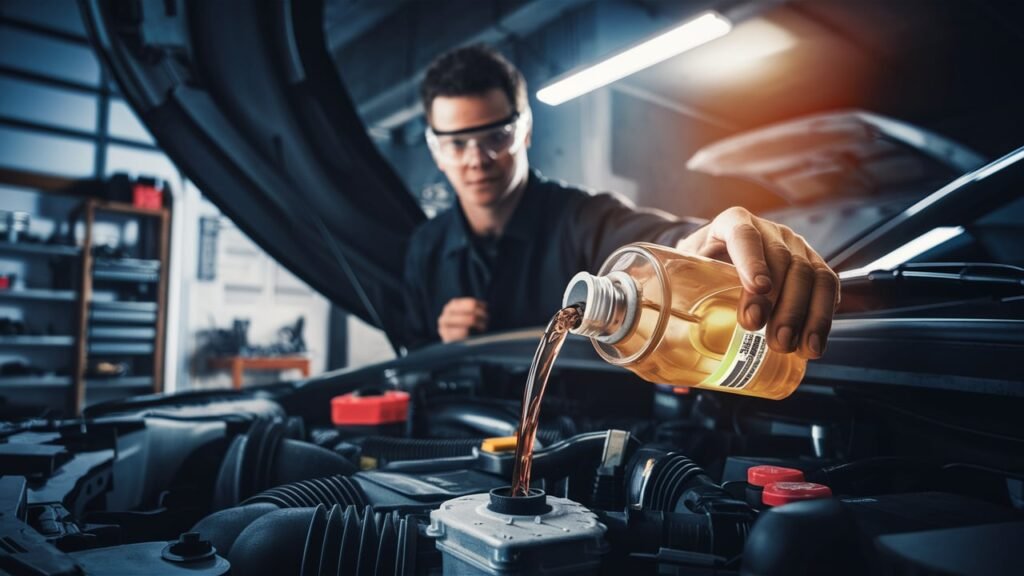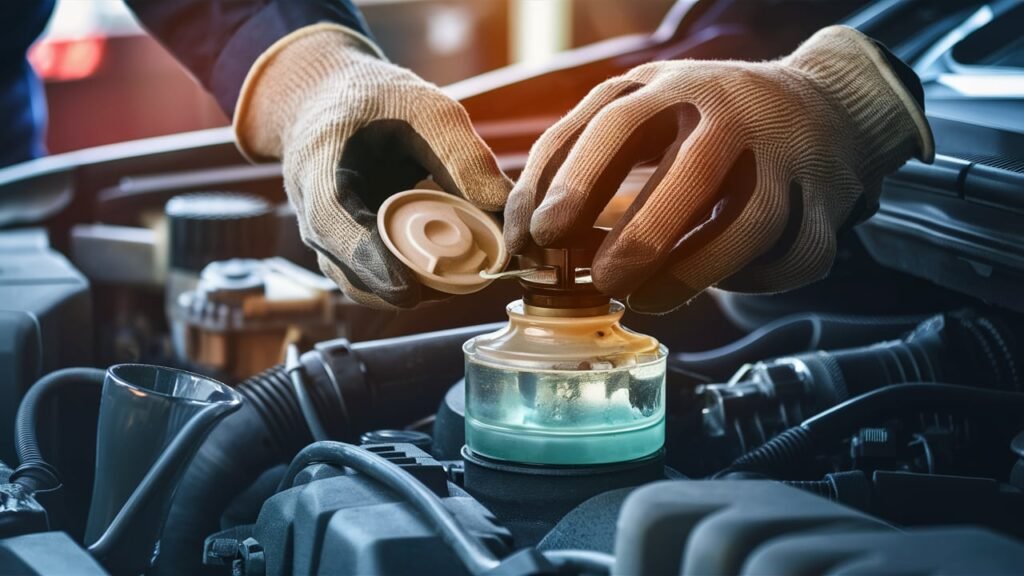
8 Steps to Conduct a Car Engine Brake Fluid Level Inspection
Regular inspection of the car engine’s brake fluid level stands as a key pillar for maintaining roadworthiness and safety. Understanding the nuances of this vital component can prevent potential hazards on the road, ensuring optimal braking performance and vehicle control.
The efficacy of your braking system hinges on meticulous attention to details like these. In this comprehensive guide, we delve into 8 meticulously structured steps that will enable mechanics, car enthusiasts, and automotive technicians to conduct an all-encompassing examination of the car engine’s brake fluid level.
The process begins with assembling a curated selection of tools and materials indispensable for this assessment. From gloves to clean rags, each item serves a paramount purpose in executing a thorough inspection procedure. Locating the sacred vessel that holds your brakes’ lifeblood—known colloquially as the brake fluid reservoir—presents itself as our first meticulous task.
Equipped with unwavering precision, identifying this reservoir amidst your vehicle’s labyrinth ensures accurate observations moving forward.
Upon pinpointing this pivotal point, a meticulous cleanup ensues where no speck of dust is left unturned before scrutinizing the current brake fluid level within the reservoir; each drop elucidates essential insights into your vehicle’s mechanical condition.
This journey brims with methodologies designed to nurture understanding and efficiency among those who seek mastery over their vehicular domains.
Step 1: Gather Necessary Tools and Materials.
Before diving into the car engine brake fluid level inspection, it is crucial to gather all the essential tools and materials required for a thorough assessment. A basic toolkit for this task generally includes gloves to protect your skin from any chemical exposure, a flashlight to illuminate hard-to-see areas around the reservoir, and a clean rag to wipe off any dirt that may obstruct your view.
Ensuring you have all these items readily available before commencing the inspection will streamline the process and help maintain focus on the task at hand.
Safety should always be a top priority when handling tools and materials in an automotive setting. When gathering items such as rags or cleaning solutions, make sure they are stored away from heat sources or potential ignition points to prevent accidents.

Additionally, be cautious with chemicals that may be present near the brake system; accidental spillage could lead to detrimental effects on both components and personal health. By taking preventive measures during tool collection, you set yourself up for a safe and efficient brake fluid level inspection.
To ensure an organized and efficient inspection process, consider preparing a dedicated space where all tools can be laid out neatly within reach. This setup minimizes time wasted searching for items mid-inspection and reduces the likelihood of misplacing crucial tools.
Being methodical in tool gathering not only enhances efficiency but also sets a professional standard for meticulous maintenance practices in automotive care.
Locating the brake fluid reservoir.
Locating the brake fluid reservoir is a crucial step in conducting a comprehensive car engine brake fluid level inspection. In most vehicles, the brake fluid reservoir can be found near the firewall on the driver’s side, close to the master cylinder.
However, its placement can vary depending on the vehicle type and model. For instance, in some cars, the reservoir may be positioned beneath a cover marked with a brake symbol under the hood, while in others, it might be more prominently visible near other engine components. It is essential to refer to the owner’s manual for specific instructions tailored to your vehicle.
Identifying the correct reservoir is paramount to avoid confusion during the inspection process. Confusing the brake fluid reservoir with other fluid compartments could lead to misinterpretations or even accidental mixing of fluids, which can be detrimental to your braking system’s operation.
Verifying that you are looking at the right component not only ensures accurate assessment but also prevents potential damage or safety hazards resulting from errors.
Accessing hard-to-reach reservoirs safely requires caution and precision. In instances where visibility or reach is limited due to tightly packed engine components, using a flashlight or mirror can aid in locating and examining the reservoir without compromising safety.
Additionally, taking care not to disturb surrounding parts or wiring while accessing the reservoir is crucial to prevent unintended damage that may result in additional maintenance requirements down the line. By following these tips and being mindful of safety protocols, you can effectively locate and prepare for inspecting the brake fluid reservoir in various types of vehicles.
Step 3: Clean Surrounding Area.
Ensuring a clean area around the brake fluid reservoir is crucial before proceeding with the inspection. Any debris or dirt near the reservoir can inadvertently contaminate the brake system, leading to potential operational issues.
To maintain the integrity of the braking system, begin by using a clean rag to wipe away any visible dirt or grime in the vicinity of the reservoir. This simple step helps prevent unwanted particles from falling into the reservoir when it is opened for examination.
When cleaning around the brake fluid reservoir, be cautious about using appropriate cleaning agents that won’t harm vehicle components. Mild soap and water are generally safe choices for removing grease or dirt without causing damage.

Avoid using harsh chemicals or solvents that could react negatively with the materials in your car’s braking system. By taking care to choose gentle cleaning solutions, you safeguard against unintentional corrosion or deterioration of critical parts in the braking mechanism.
An example scenario illustrating why thorough cleaning is essential could involve encountering a spillage near the brake fluid reservoir that has pooled dust and oil residue around it.
Failing to clean this area properly before inspecting the brake fluid level may introduce contaminants into an otherwise well-functioning brake system, potentially compromising its performance. By diligently maintaining cleanliness in this specific area, you uphold the efficiency and safety standards of your vehicle’s braking function while prolonging its longevity.
Step 4: Inspect Brake Fluid Level.
To accurately assess the brake fluid level in your vehicle, start by locating the translucent brake fluid reservoir typically positioned near the firewall on the driver’s side of the engine compartment. Remove the cap and observe the current brake fluid level.
If it’s below the designated “Minimum” mark, this indicates that more fluid is needed for optimal performance. Conversely, if it surpasses the “Maximum” mark, excess fluid should be removed to avoid potential issues with braking responsiveness or overheating.
When interpreting different levels during inspection, keep in mind that low brake fluid levels could signal a leak in the system that needs immediate attention from a qualified mechanic.
Alternatively, excessively high levels may point towards contamination or a recent overfilling mistake. Address these discrepancies promptly to preserve your vehicle’s safety standards and prevent costly repairs down the line.
In cases where unexpected findings arise during the inspection—such as discolored or cloudy brake fluid—it’s crucial to address these concerns promptly as they can indicate moisture infiltration or contamination affecting your braking system’s efficiency.
Any particles or debris found in the reservoir could potentially compromise brake performance and should prompt further investigation by a professional to ensure safe driving conditions are maintained.
Step 5: Check Fluid Condition.
Assessing the quality and condition of brake fluid is vital for maintaining a vehicle’s braking system. By inspecting the color and consistency of the brake fluid, you can gain valuable insights into the health of the hydraulic system.
Fresh brake fluid typically has a clear or slightly amber color; however, over time, it tends to darken due to exposure to heat and moisture. A dark brown or black hue indicates contamination or degradation, suggesting that the fluid may no longer effectively transmit hydraulic pressure, compromising braking performance.
Contaminated brake fluid poses significant risks as particles and debris can accumulate in the system, leading to corrosion of components such as calipers and master cylinders. In severe cases, contaminated fluid can cause brake failure or damage critical parts of the braking mechanism.

\Signs of degradation include a thickening or separation of the fluid, which might hinder its ability to flow smoothly through the hydraulic lines. These indicators signal the need for immediate action to prevent potential safety hazards on the road.
To determine whether brake fluid requires replacement based on its condition, perform a visual inspection and note any unusual characteristics. If you observe discoloration, cloudiness, or sediments in the fluid, it is advisable to consult a professional mechanic for further evaluation.
Additionally, if you suspect water contamination in your brake fluid—visible as white streaks—or notice a foul odor emanating from the reservoir, it is crucial to address these issues promptly by flushing out and replacing the brake fluid. Regularly monitoring and maintaining the quality of your car’s brake fluid ensures optimal braking performance and enhances overall driving safety.
Step 6: Top Up Brake Fluid (If needed).
In the event that your inspection reveals low brake fluid levels within safe parameters, the next step is to top up the brake fluid. This process helps maintain optimal performance and ensures the braking system functions effectively.
When adding more brake fluid, it is crucial to use the type specified by the manufacturer to prevent any adverse effects on the braking system. Using an incorrect type of brake fluid can lead to seal damage, corrosion, or even brake failure. Always refer to the vehicle’s manual for the correct specifications.
To avoid overfilling or spillage during the topping up process, follow these tips. Start by using a funnel to carefully pour the brake fluid into the reservoir, ensuring a steady hand and controlled pouring to prevent spills.
It’s essential not to overfill beyond the maximum level indicated on the reservoir as excess brake fluid can overflow when heated, potentially causing damage or safety hazards. Take your time and monitor levels closely while adding fluid gradually until reaching the recommended level.

For example, if you are working on a modern sedan with an opaque reservoir tank, ensure proper lighting and positioning to accurately gauge and control how much brake fluid is poured. The wrong amount could affect pedal feel and braking efficiency significantly.
By following manufacturer guidelines and employing precision in this step of replenishing brake fluid, you contribute to maintaining your vehicle’s safety standards and performance capabilities effectively.
Step 7: Securely Close Reservoir.
Once you have completed the inspection or topped up the brake fluid as necessary, it is crucial to securely close and seal the brake fluid reservoir to prevent any leaks or contamination. To ensure a proper seal, follow these guidelines meticulously.
First, gently place the cap back on the reservoir, making sure it is securely fastened but not overtightened to avoid damaging the threads. Double-check that there are no debris or dirt on the rim of the reservoir opening before closing it.
Safety should always be a top priority when dealing with brake components. Remind yourself of the importance of preventing any foreign substances from entering the brake system by sealing the reservoir tightly.
Consider using gloves during this process to avoid transferring oils or dirt onto critical brake parts. By maintaining cleanliness and using caution while handling components, you reduce the risk of introducing contaminants that could compromise braking performance.
To finalize the closure effectively without causing harm to any elements, ensure smooth threading of the cap onto the reservoir neck. Be mindful not to cross-thread, as this may lead to leaks or improper sealing, impacting your braking system’s efficiency.
Taking these extra steps in securely closing the reservoir demonstrates your commitment to thorough maintenance practices that contribute to vehicle safety and performance longevity.
Conclusion.
In conclusion, conducting regular inspections of the car engine brake fluid level is paramount for ensuring vehicle safety and optimal performance. By following the 8 detailed steps outlined in this guide, mechanics, car enthusiasts, and automotive technicians can proactively maintain the braking system’s integrity.
These inspections not only help in identifying potential issues early on but also contribute to preventing more severe problems that could compromise driving safety.
Neglecting to check and maintain the brake fluid level in a vehicle can have serious consequences. Over time, contaminated or degraded brake fluid can lead to impaired braking performance, increased stopping distances, and even brake failure in extreme cases.
Furthermore, ignoring this essential maintenance task may result in costly repairs or accidents due to compromised braking efficiency. Therefore, by prioritizing routine checks of the brake fluid level, individuals can safeguard both their vehicles and their own well-being on the road.




